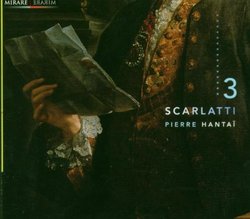| All Artists: Domenico Scarlatti, Pierre Hantaï Title: Scarlatti 3 - Pierre Hantaļ Members Wishing: 0 Total Copies: 0 Label: MIRARE Original Release Date: 1/1/2006 Re-Release Date: 2/14/2006 Album Type: Import Genre: Classical Styles: Chamber Music, Forms & Genres, Sonatas, Historical Periods, Baroque (c.1600-1750), Classical (c.1770-1830) Number of Discs: 1 SwapaCD Credits: 1 UPC: 3760127220077 |
Search - Domenico Scarlatti, Pierre Hantaï :: Scarlatti 3 - Pierre Hantaļ
 | Domenico Scarlatti, Pierre Hantaï Scarlatti 3 - Pierre Hantaļ Genre: Classical
|
Larger Image |
CD Details |
CD ReviewsHantai's Best Scarlatti Disk G. Winford | Whidbey Island, WA | 02/15/2006 (5 out of 5 stars) "Hantai's third volume in his on-going Scarlatti series on Mirare came unexpectedly, for, while it took him two years to release his follow-up to the first volume, the third volume was released a mere eight months after the second volume.
This volume immediately rights the only weakness of the second volume, for it has a nice balance between up-tempo and slower sonatas-which I feel is often necessary to convey the full emotional range of Scarlatti as a composer and to vary the listener's experience over the course of a lengthy program. Indeed, to those familiar with Scarlatti's work, the slower sonatas offered here (K213, K8, K526, K466, K151, and K27) are some of the most immediately recognizable sonatas on this disk. This volume opens with a meditative statement of purpose, an expansive 7:12 minute reading of K213. Whatever the tempo marking, Hantai is generally known for briskness, but here he seems to be deliberately exploring every note, nuance, and emotion of the piece, giving the notes plenty of room to pulse and resonate. In this sonata, Hantai discovers a beautiful, meditative, and anxious world. It is fully engrossing, and Hantai's detailed reading gives the listener much to explore; once you get in there, it is an enormous room-those baroque ceilings are awfully high. Hantai takes the first section of K227 as celestial music of the spheres, giving the opening notes especially room to breathe. And the scale runs alone at the end of the first section are mesmerizing. Yet Hantai is only lulling the listener into a false sense of peace to delight in the abrupt change of tempo and tone in the second half of the sonata. By Scarlatti's own standards, the shift between the first and second sections of this sonata is extremely brusque. Hantai snaps the listener out of their dream with a frenetic second half that is all speed, dance, and ecstasy. He drastically accents the opposition of the binary halves, and, in doing so, creates one of his finest performances on the disc. His frenzied reading of K56 provides some of the most demonic rhythms that I have heard in a Scarlatti performance. A quick comparison with his previous version of K56 (on his Astree disk) reveals that this reading's rhythms are much sharper and stronger than the rhythms of his previously recorded effort. He has traded the humor and playfulness of his earlier account for a diabolical and savage drive. Hantai's fingers execute precision whips and slashes at the keys. The left hand's rhythms in particular are stunning. The performance is savage, yet the counterpoint and clarity of the piece is never compromised; the architecture of the piece is never clearer. It's a precision study in rhythm and movement, and its motion so convincing that it seems to leave the realm of music altogether and be an exercise in physics; the music becomes centrifugal force personified; it swings wildly but never loses control. I would have to put this sonata on my short list of Hantai's finest performances. This disk provides many more strong moments: a dizzying reading of K511 that flawlessly highlights Scarlatti's two-part counterpoint; a version of K8 that is played at a much brisker tempo that most piano players (who often seem to approach it as if were written by Mahler!) and thus turns it into a softly drifting piece of wistful melancholy; a similar approach pays off on the frequently recorded K466. K526 and K151 come off with a gorgeous grace and fragility. The liner notes say that Hantai uses the same harpsichord in the third volume as the second volume. The closeness of the second and third volume makes me wonder if these sonatas were not recorded at the same sessions as the second volume. To my ears though, this instrument seems to sing and ring a bit more than the volume two instrument. It sounds better. I have to wonder if the liner notes are incorrect or if the third volume was not engineered or mastered better. The liner notes and packaging are largely recycled-which is inevitable I suppose as the series increases in volumes. The interview and timeline from the second volume are reprinted. Hantai's own liner notes are always a delight, and he does satisfy the listener's desire for something new with a brief essay on determining the chronology of Scarlatti's sonatas. The bottom line? This might very well be the best Scarlatti disk that Hantai has recorded. The sonata selection offers breadth and depth. The slower pieces in particular shine. The technique, as always, is flawless and stunning. It would criminal for any aficionado of Scarlatti to not have this disc in their collection; it would also be a great place to start for those interested in exploring Scarlatti's music. Let us hope that the fourth volume follows the third as quickly as the third followed the second. " |

 Track Listings (16) - Disc #1
Track Listings (16) - Disc #1